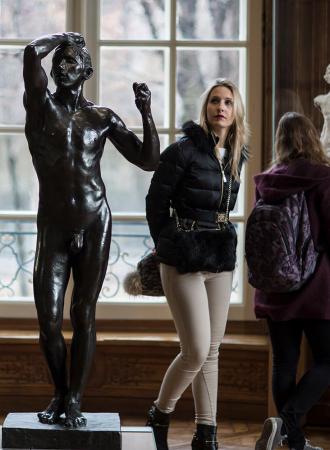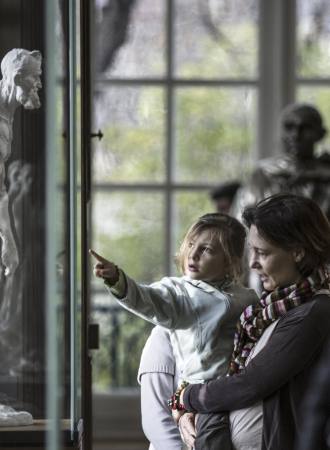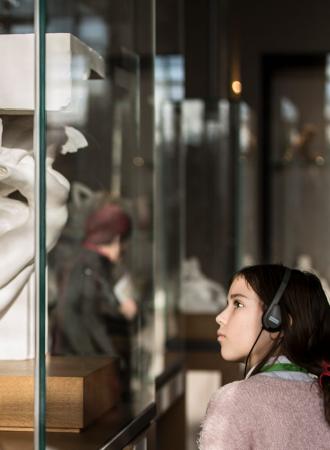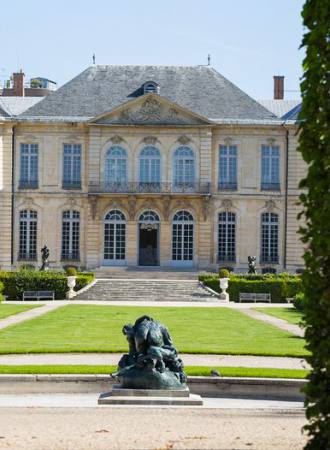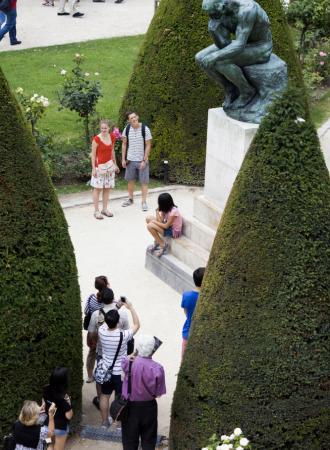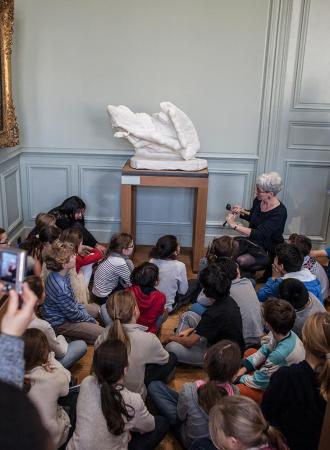Search the site
Multiples, fragments, assemblages
In 1907, Rodin had a large-scale bronze cast made which he entitled The Walking Man. A smaller version, designed in the late 1890s based on fragments from Saint John the Baptist (1880), had already been shown during the exhibition in the Pavillon de l’Alma in 1900. This early plaster version was put together using fragments from the study phase of Saint John the Baptist: a crackled torso, forgotten about and left lying in the studio for years, and a pair of legs, which Rodin combined without attempting to conceal the join marks. Perched atop a column two metres high, amidst a group of other sculptures, the work was hardly noticed in 1900, despite its strange appearance (a torso stuck on top of two legs, with neither arms nor head). But when Rodin decided to have this figure enlarged by Henri Lebossé, in 1905-06, and to have it cast in bronze, he endowed it with a new monumentality and powerful expressive force.
Vue de l'oeuvre
The aesthetic revolution achieved in this work, which was to influence his own and future generations of sculptors (Boccioni, Giacometti…), came about when the artist was at the height of his powers, but was the end product of a thought process and working method that had begun in Rodin’s youth, during his training and employment in Carrier-Belleuse’s studio.
ORIGINS
In the 1870s, under the direction of Carrier-Belleuse, and in tandem with the monumental sculpture destined to adorn Brussels’ new public buildings, Rodin executed a series of decorative clay busts and figures to be used as models for mass production. He learnt how to get the most out of a single model, cast in multiples, by reworking the new clay models thus obtained and adding variations, if need be, before firing. One example of this type of working method is provided by the female figure – alone or combined with others, nude or clad in drapery, with hair in a chignon or hanging loose, with a cherub on her knees or beside her – as can be seen in Venus (1871) Cupid’s Secret (1871), Venus and Cupid (1871), and The Toilette of Venus or The Spring (1871). Another example is the bust of the young woman which, c. 1872, was the starting point for a series of variants (in the hairstyle, accessories, base) entitled La Lorraine (or Innocence, Modesty, The Village Bride, The Daughter of Mme Angot).
MULTIPLES AND ENLARGEMENTS
Because it enabled figures or fragments of figures designed earlier to be reproduced and multiplied, then combined differently in new compositions, notably for commercial purposes, casting was a very widespread practice in 19th-century sculptors’ studios. Making a plaster cast was also a technical requirement in the process of casting a bronze or carving a marble.
Rodin’s innovativeness resided in the fact that this technique became a systematic part of his creative process. Thus for The Gates of Hell, Rodin made multiple plaster casts of figures or fragments of figures whose poses or modelling pleased him. Cast from the same original work modelled by Rodin, several of them appeared two or three times on the finished Gates, arranged in different positions so as to confer new attitudes and meanings upon them: Fugit Amor appeared twice, and later became an independent group (before 1887) , while one of the two figures comprised in this group turned into The Prodigal Son, a large-scale bronze of which was cast in 1905.
Rodin also took advantage of the opportunities that multiplication afforded within a work, using the same figure in different positions: the inspiration for Three Faunesses (before 1896) was thus drawn from a figure Rodin employed four times on The Gates of Hell. Likewise, the male figures in The Three Shades (before 1886) were borrowed from Adam (1880-81, itself inspired by the pose of Michelangelo’s Slaves).The three identical figures, grouped around a central point, initially placed at the top of The Gates of Hell, were enlarged in 1904 to create a monumental independent group.
Vue de l'oeuvre
Rodin began most of his sculptures by modelling small versions of them, which made them easier to handle and enabled the sculptor to pursue his creative idea without having to worry about technical constraints, as in The Kiss, for example. Having an enlargement made of them also enabled Rodin to avoid accusations of making life casts, as he had faced during The Age of Bronze affair. Profiting from the machine invented by Achille Collas in 1830, based on a pantograph system, Rodin employed skilled assistants, notably Henri Lebossé from 1894, for making enlargements or reductions of his models.
Initially used by Rodin in a manner similar to other sculptors, for figures related to the monuments of the 1880s and 1890s (The Burghers of Calais, Victor Hugo, Balzac), the enlargement process of a model gained the status of a new working method, conferring monumentality and new vigour upon works conceived twenty years earlier such as The Thinker (1903) and The Walking Man (1907). Rodin played on the expressive potential afforded by the enlargement of a figure and its bronze cast: the marks made by his fingers when modelling acquired greater force.
ASSEMBLAGES AND PARTIAL FIGURES
In the 19th century, a sculpture was only be regarded as finished if its subject were identifiable, and if it were a complete figure, except for portrait busts. Rodin, moreover, paid the price for not respecting these conventions with his Mask of the Man with the Broken Nose (1864) : all that was saved of the head when it froze and cracked, the mask was refused by the Salon jury in 1865. Inspired by Michelangelo (the Slaves, 1513-15, Louvre, Paris) and ancient marbles that had come down through the ages in fragmentary form, Rodin began to explore the partial representation of the human body at an early stage of his career: in 1874, he chose to borrow the motif of the ancient marble Belvedere Torso to symbolize sculpture in the Allegory of the Arts on the decorative scheme for the Palais des Académies, in Brussels. In the 1880s, Rodin boldly included fragments in his exhibitions, notably the show with Claude Monet at the Galerie Georges Petit in 1889, where he presented two torsos and two masks.
In the late 1880s, in the period of intense activity revolving around The Gates of Hell, Rodin built up a large stock of models of complete figures and fragments, which he could delve into whenever he wanted to experiment with assemblages and transformations. In the early 1890s, Rodin continued his investigations into partial figures (commenced with the Torso of the Walking Man in 1878). He dismantled and reassembled existing sculptures in endless combinations. By casting different parts of figures separately, he could rework the overall composition of a piece, without having to rework everything. Rodin joined his sculptural studies, or bozzetti (c.1890-1900), onto other figures through a process he called marcottage, generally leaving the joins visible in the finished sculpture, thus reviving the idea of non finito borrowed from Michelangelo.
While Rodin drew his inspiration from ancient statuary and Michelangelo’s works, especially fragmentary figures, his own works should be discussed more in terms of partial figures. A fragmentary figure is initially executed as a whole figure, which is subsequently damaged. In a partial figure, only the elements that are visible were actually executed, as was true of Rodin’s works, even if most of his partial figures made after 1890 were casts and enlargements of earlier works. By enlarging fragments of figures, instead of whole figures, Rodin abandoned the practice of representing the body in its entirety, thereby freeing himself from Phidias and Michelangelo’s artistic canons and problematic issues of anatomical proportions. Flawless in form, the fragment thus earned its independence, broke away from the figure to which it had originally belonged, and became a work of art in its own right. When reproached for only showing “simple parts of the human body”, Rodin defended the expressive force of the partial figure: “Those people,” he said, “didn’t they understand anything about sculpture? About study? Don’t they think that an artist has to apply himself to giving as much expression to a hand or a torso as to a face? And that he is logical and far more of an artist to exhibit an arm rather than a “bust” arbitrarily deprived by tradition of its arms, legs and abdomen? Expression and proportion are the goals. Modelling is the means: it’s through modelling that flesh lives, vibrates, struggles and suffers…” (Rodin cited by D. Viéville, Rodin-Freud, p. 165)
The clay model of Torso of Adèle, a small, strikingly sensual, partial figure, executed before 1884, was thus used as a base, once completed with arms and legs, for one of the figures on the upper left-hand corner of The Gates of Hell. On another occasion, modified and fitted with a head, it became the starting point for the female figure in Eternal Springtime (c.1884).
An enlarged version of a figure originally designed for The Gates of Hell was used in Christ and Mary Magdalen (c.1894).
Vue de l'oeuvre
The same figure, stripped of her arms, became Meditation (or The Inner Voice, 1896) and was exhibited as an independent work in 1897. In his monograph on the sculptor, Rainer Maria Rilke wrote: “Never was human body assembled to such an extent about its inner self, so bent by its own soul… all the armless statues of Rodin; nothing necessary is lacking. One stands before them as before something whole.”
THE ANTIQUE FRAGMENT. RODIN’S COLLECTION “IN PROGRESS”
Parallel to his experiments with partial figures from the early 1890s onwards, Rodin’s collection of ancient sculptures and objects found a home conducive to its growth at the Villa des Brillants, the property Rodin purchased in Meudon in 1983. Living amidst his antique statues, Rodin designed mises en scène to enhance the pieces in his collection, arranging them on the bases and plinths of his own sculptures, occasionally covering them with drapery when he wanted to conceal a part that he considered not graceful enough, and only exhibiting what he regarded as beautiful. Rodin sometimes mounted and “restored” some of his ancient statues himself, proceeding in the same manner as for his assemblages, as shown in the 2nd-century marble Portrait of a Woman, literally planted in a block of plaster to join it to the pedestal.
The antiques purchased by the sculptor did not comply with the conventional criteria followed by museums and academies. He was usually more interested in an ancient statue that had survived in fragmentary form “as handed down by time, dug up out of the earth, having lost not only its identifying, iconographic and sometimes even stylistic attributes but also its exact geographical provenace in the course of its tribulations.” (B. Garnier, in Rodin-Freud, p. 68)
These partial figures often recalled key works that Rodin had seen in his youth, in museums or in Italy: echoes of the Parthenon sculpture were thus found in fragments of more modest ancient statuary, while Rodin’s view of the Antique distanced itself from the idealized beauty of its masterpieces. In a fragmentary form, an ancient statue offered an unprecedented representation of the human body, reduced to a detail, unfettered by the classical canon of proportion. Freed of its iconographical attributes, vestige of a group perhaps comprising other figures, the fragment no longer illustrated the Antique at the height of its glory, but conveyed a memory of it, like a lingering trace of a former life. Rodin loved to look at his ancient sculptures “by candlelight”, which offered a flickering glimpse of the works and heightened the sensuality of the carved stone.
His collection was a direct source of inspiration for Rodin, as evidenced in Female Torso with the Hand of a Skeleton on her Belly (c.1890?), the subject of which was borrowed from an ancient statue in his collection.
Vue de l'oeuvre
Rodin also made casts of vases, urns and funerary stelae with a view to using them in his own compositions. A plaster cast of the 2nd-century Funerary Altar of A. Ravius Epictetus was thus incorporated into one of the versions of The Whistler Muse. To rid himself of colour and motif, Rodin also employed this process to reproduce some of his ancient vases in plaster, as in Geometric Style Cup with Bird Decor (2nd half of the 6th century BC), which became the base for the figure of Galatea severed at the Thighs in a Cup (1895-1905?).
Rodin further experimented with incorporating his collection of antiques into his creative process. From 1895, he used authentic small antique terracotta vases in a series of works where they were combined with casts of small female figures. Playing very freely on contrasting scales, these vases became containers with either figures clambering out of them (Female Nude seated in an Urn, 1895-1905?) or completing them: Despairing Youth and Torso of a Child of Ugolino thus became vase handles (1895-1905?). The collector’s item was thus incorporated into the sculptor’s oeuvre. It became one of its constitutive elements, which the artist combined with a figure.
Vue de l'oeuvre
“In this dream of the Antique, the true revolution lay in this mix of objects from the past with works in progress, an uncommonly rare concept in the long history of artists’ collections.” (B. Garnier, Rodin-Freud, p. 80)
The collection of antiques can thus be regarded as a collection “in progress”. It did not simply gratify an obsessive desire to possess a rare object; it was not only a major source of inspiration for Rodin, but also, in his vase-and-figure assemblages, constituted the very substance of creation and artistic innovation.
It thus played a full role in Rodin’s working method, based on extracting the autonomous fragment from the heart of a figure and exploiting its expressive qualities.
![Auguste Rodin, Vénus ou petite nymphe assise se peignant [S.295], Vénus et l'Amour [S.294], Source, La toilette de Vénus [S.1193], Secret d'Amour [S.355] Auguste Rodin, Vénus ou petite nymphe assise se peignant [S.295], Vénus et l'Amour [S.294], Source, La toilette de Vénus [S.1193], Secret d'Amour [S.355]](/sites/default/files/styles/slider_simple/public/3445_1baef9fc5b81cfb.jpg?itok=UF4Teku_)
![Auguste Rodin, L'Enfant prodigue, [S.1130] Auguste Rodin, L'Enfant prodigue, [S.1130]](/sites/default/files/styles/slider_simple/public/3446_d5e48887f865fe4.jpg?itok=evNQsN4u)
![Auguste Rodin, Abattis, [S.4650] Auguste Rodin, Abattis, [S.4650]](/sites/default/files/styles/slider_simple/public/3450_635f83216353f8e.jpg?itok=ZY1_EpGe)
![François Vizzavona, La collection d'antiques dans l'atelier Tweed à Meudon [Ph.6135] François Vizzavona, La collection d'antiques dans l'atelier Tweed à Meudon [Ph.6135]](/sites/default/files/3453_64c96a193b26b9d.jpg)
